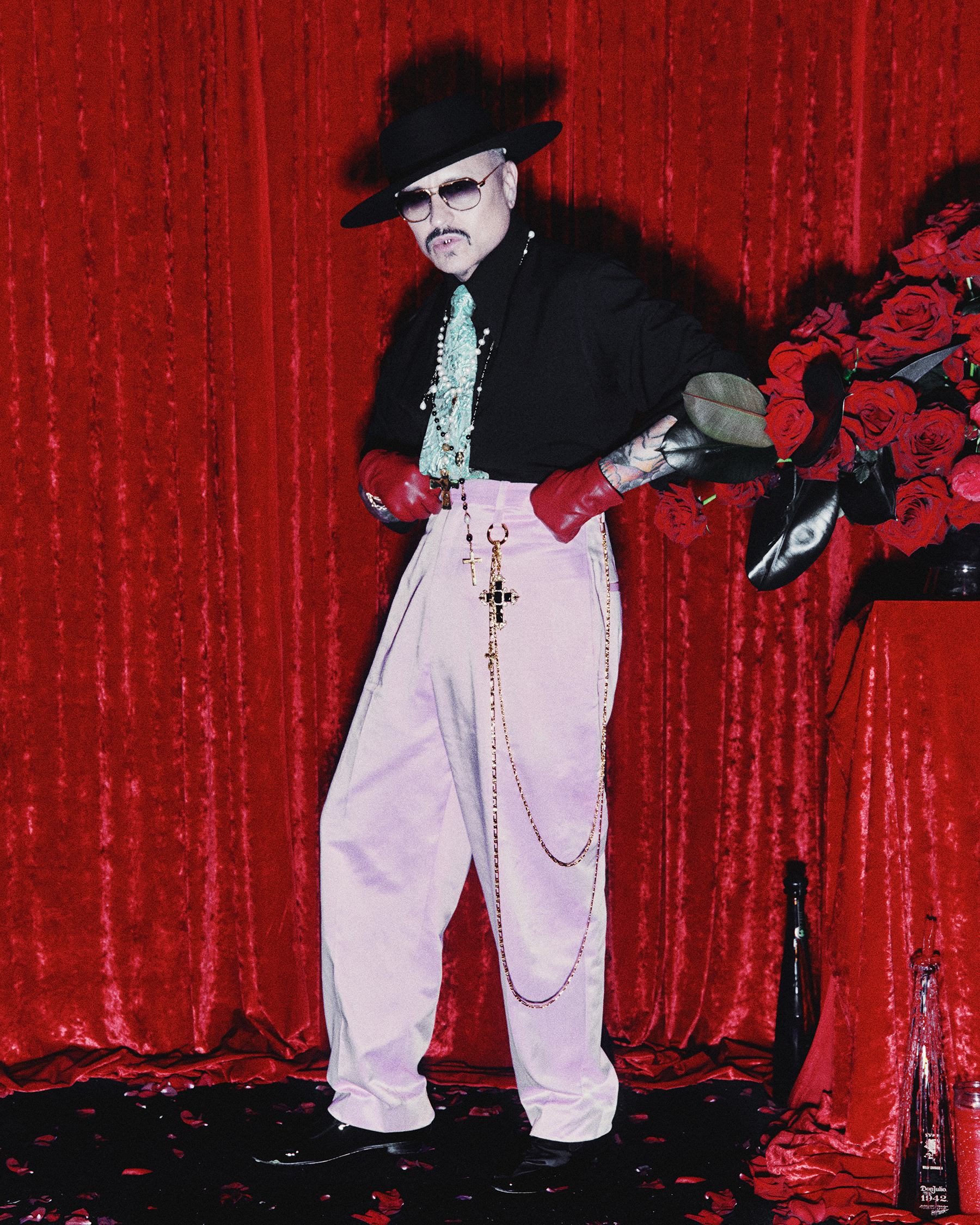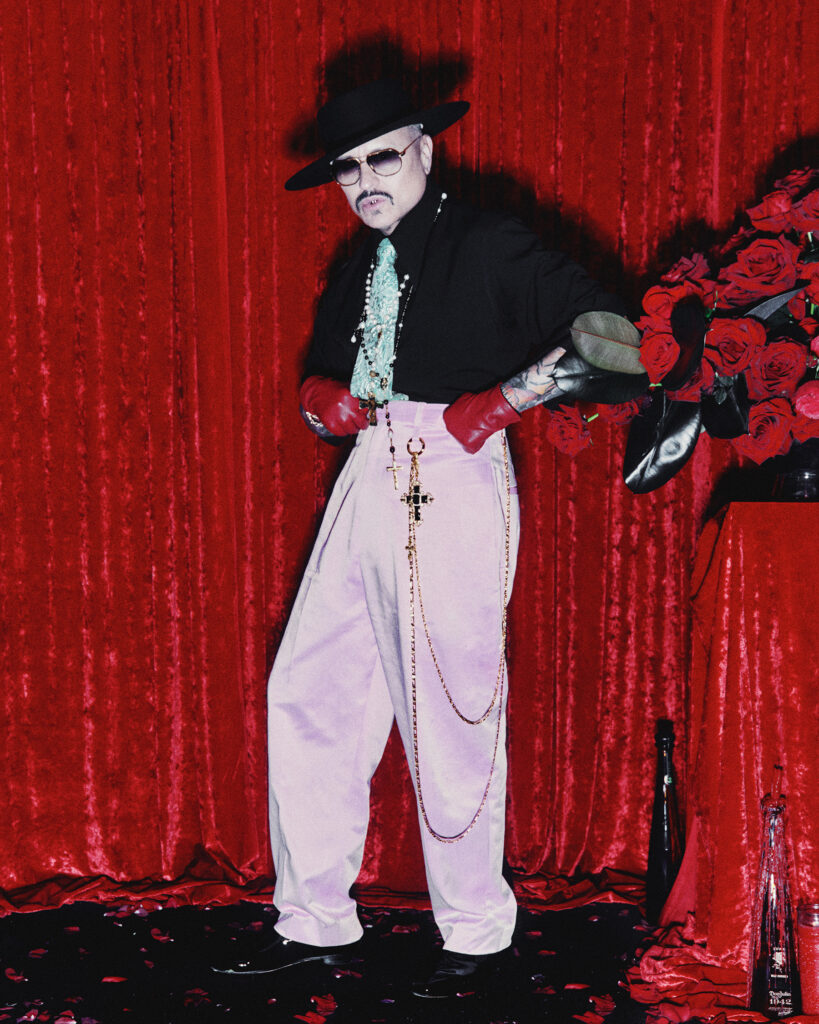At a time when the American political landscape feels increasingly hostile toward immigrants and marginalized communities, Willy Chavarria stands as a vital force in fashion, proving that clothing can be both a canvas for aesthetic innovation and a vehicle for resistance. His collections speak to issues of identity, dignity, and belonging with a clarity that few in the industry dare to match. But it’s not just his politics that make him essential; it’s his taste. With an eye that bridges streetwear and elegance, activism and allure, Chavarria has quietly become one of the most important living designers working today. In this conversation with V, he reflects on the Met Gala, the evolution of fashion’s “old guard,” and the power of kindness as a design ethos.
Willy Chavarria: It’s nice to meet you.
Mathias Rosenzweig: Nice to meet you, too. So, are you in New York or California at the moment?
WC: I’m based in New York. My husband and dog are in New York, and we travel a lot together because he’s a co-owner of the business. We’re in it together. But yeah, my home is New York, for sure.
MR: I wanted to start with that and ask about your experience at the Met Gala this year. What was it like for you?
WC: Well, this year was different than any other year, really. It was because of the invite list and the performance. Normally, it’s all about the stairs and the exhibit. But this event was extremely lively. Stevie Wonder and Usher performed. I went with Usher and sat at his table, so it was the most incredible thing. Not a person was in their seat—everyone was dancing. It was so completely alive with celebration. It was beautiful, so incredible.
MR: So what you’re saying is—it’s actually fun once you’re inside.
WC: I think so, yeah. This time was incredibly fun. I was much less nervous than at previous Met Galas. I’ve been to a few before, but I didn’t have the anxiety I usually feel being around all those famous people. This time I felt a lot more relaxed. I was with Maluma, who’s so cool, and we were just having a good time even before we went. And I knew I had the afterparty to look forward to—which was amazing. With Don Julio. Vogue called it “the finest party of the night.”

Photograph by Diego Bendezu
MR: Yeah, when I talk about FOMO, I really mean the afterparties. They look so fun.
WC: Usually, it’s the afterparties that everyone goes to. Everyone dresses up for them. The city becomes the Met Gala. This year, I actually had an afterparty, and it was incredible. Don Julio and I have been doing things together for a while, and over the years our relationship has grown. When we come together on a celebratory moment, it’s this amalgamation of the Willy vibe and the Don Julio elegance—roses, amazing cocktails…
MR: What’s so special about your brand is that it feels luxurious, but also approachable. It’s political but friendly. It’s not like those old-school Parisian houses where everything’s black and cutthroat. People ask me, “Is fashion really like The Devil Wears Prada?” and I’m like, “It’s like that if everyone were on crack.” And I think your brand resonates because it doesn’t feel like that—it feels inclusive. How do you operate between those two things: the expectation of being a serious fashion house, but also not wanting to be elite or exclusive?
WC: I really appreciate you saying that, because that’s the impact I hope to have in fashion. As my brand grows and I gain more influence in the industry, one thing I’d like to change is the need to make it more kind. That’s the biggest stumbling block—the old guard. I often talk about how there’s this old guard of fashion that’s still stuck in place. It’s still guiding the houses and the big corporations. It’s very Devil Wears Prada. But the new generations are leading a different perspective, and the old guard hasn’t yet transitioned to meet that new way of thinking. All these brands are trying to tap into the community and Gen Z, and it’s actually very simple: take risks. Connect with people as people, not just customers. And remember—the art in fashion is just as important as the business. That’s what I hope to change.
MR: I moved to New York in 2009, and back then, it felt like being cold and mysterious was part of being cool. You had to be a little mean. But Gen Z—honestly, they think being an asshole is very uncool. They’re not aligned with that old guard at all.
WC: No, not at all. That’s not cool anymore. You can still have edge, still play with identity and have fun with it—but at the core, what we’re doing should be founded in kindness. It’s so simple.
MR: This might be oversimplifying, but do you think any of this approach comes from your upbringing, especially growing up in California, not New York or Paris like a lot of your contemporaries?
WC: Yeah, 100%. I was just in my hometown a couple of weeks ago, and it was really reaffirming. Driving away, I realized that town made me exactly who I am. The love, the values, the commitment to family—that’s stayed with me my whole life. It’s probably good I didn’t grow up with fashion magazines, or even People magazine. It wasn’t until I was older that I discovered the business behind it all.
MR: It gives you a different taste and perspective. People in the industry—like you or me—have this warped view of fashion. But the people who actually buy clothes are outside that bubble. Your background gives you a more grounded outlook.
WC: I think so. But it felt like a hurdle early in my career—adjusting to the industry, getting jobs, not knowing certain things. My first big job in fashion was at Ralph Lauren. I was like a deer in headlights. I remember being in a meeting and not knowing what “Black Watch” was—an English plaid. I almost lost my job over that. I was like, “Oh my God, I’m from the sticks.”
MR: I don’t know if you saw the news yesterday about the white South African immigration plan, but it’s terrifying. I know you talk about this often, but I’m curious how you’re thinking about it now—how it’s factoring into your work or just your daily state of mind.
WC: It is shocking. Definitely, where I am right now, what I feel I can do to offer resistance to hate or oppression is to help remind people to stay in and build communities. That word is overused, but in a time of oppression, it’s even more important not to isolate. Especially people who don’t live in big cities. For those in more rural areas without access to support systems, it’s important to form community, even digitally. Get involved with organizations like the ACLU. When we take action, not only do we affect the future, but we also feel better. We’re stronger when we act together. That’s where I am right now—also just reminding people that there’s still beauty in the world. We have to preserve some form of positivity. Continue to find reasons to celebrate, to fall in love, to appreciate life.
MR: I’ll pivot to something lighter. I’ve seen you say that sometimes your collections are inspired by specific people you know, and you build looks around them. Do you tend to start with a similar process every time, or is it different with each new collection?
WC: For my own collections, I have a particular process that I love. I’m grateful I can do that with my own brand—it’s harder with bigger companies. There, you sell a concept and follow it through strictly. But with my brand, we start with conversation. How do we feel? What’s happening in the world? What do we want to say with the clothes? Then my team and I look at old and new pictures, gather references, and build storyboards. We drape, choose fabrics, talk about fit—structured or relaxed—based on the current moment. The collection evolves over about four months, and by the time we’re ready to show it, we feel very plugged in and confident in the message.
MR: Every marketing agency says something like, “We don’t do marketing, we tell stories.” But with your shows, it really does feel like a set of characters.
This is a hard one, but can you think of the most beautiful thing you’ve ever seen? Whether it’s a painting, person, jacket, model, photo shoot—whatever comes to mind.
WC: The first thing that comes to mind is the ocean. I love the ocean—looking at it, living by it. It puts me at peace. Not just the visual, but the smell, the air—so inspiring. And then, the Vatican.
MR: Wow. Honestly, that makes sense.
WC: I saw it as a preteen for the first time and was floored by the beauty. The grandeur, the Michelangelo paintings—it left such an impression. I still reflect on those images.
MR: The Catholic aesthetic is unmatchable.
Okay, last one. You mentioned Don Julio earlier—it wasn’t a one-off. You’ve partnered for a while. Can you talk a bit about that connection? Are you a tequila drinker? Any personal resonance there?
WC: I’m very particular about partnerships. Every one I do has to connect with me and the brand. Don Julio has been a very organic collaboration. Tequila is part of my culture and history. Don Julio is beautiful, tasteful, elevated—it matches our aesthetic. The idea of celebration, of Don Julio being present in joyful moments, it fits how I deliver the brand message. At our Paris show, we served Don Julio when guests arrived. That sense of warmth and joy—that’s why we’ve connected so well. Now we’re doing Met Gala parties, and the day after, we had another incredible event in LA, launching the Adidas collaboration. And we’ve got more cool things coming up.
Discover More

